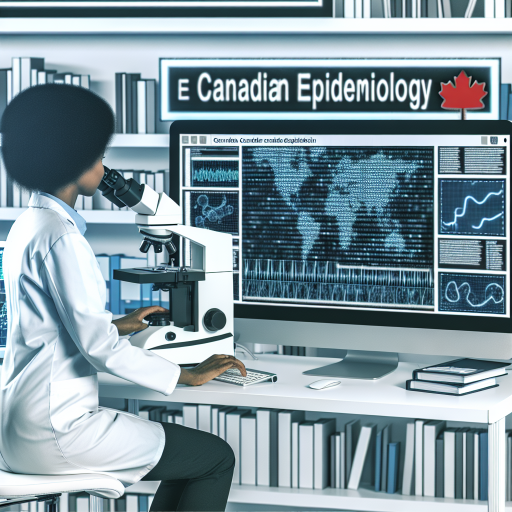Introduction to Epidemiology
Definitions
Epidemiology is the study of diseases within populations.
It examines how illnesses spread and their impact on health.
Epidemiologists investigate factors influencing health outcomes.
This field uses statistical methods for data analysis.
The ultimate goal is to enhance public health strategies.
Key Concepts
Incidence refers to the number of new cases in a specific timeframe.
Prevalence measures existing cases within a population at a point in time.
Morbidity indicates how many individuals experience illness.
Mortality reflects the number of deaths caused by a disease.
Risk factors contribute to an individual’s likelihood of developing a condition.
The Importance of Epidemiology
This field informs public health policies and interventions.
Epidemiology identifies outbreaks and patterns of diseases.
It provides data essential for vaccine development.
The insights gained guide resource allocation in health services.
Furthermore, it promotes health education and disease prevention.
The Historical Development of Epidemiology and Its Impact on Public Health
Early Beginnings
Epidemiology has origins dating back to ancient civilizations.
Hippocrates is often credited as the first epidemiologist.
He observed the impact of environment on health in ancient Greece.
These early observations laid the groundwork for future studies.
The Role of the Black Death
The Black Death in the 14th century prompted significant change.
It catalyzed the establishment of public health measures.
Quarantine laws emerged in response to widespread disease.
This was a pivotal moment for epidemiological practices.
Modern Epidemiology’s Emergence
The 19th century marked the emergence of modern epidemiology.
John Snow’s work during the cholera outbreaks was revolutionary.
Unlock Your Career Potential
Visualize a clear path to success with our tailored Career Consulting service. Personalized insights in just 1-3 days.
Get StartedHe identified water contamination as a source of the disease.
His methods exemplified the application of statistical analysis.
Epidemiology and Public Health Policies
As epidemiology advanced, so did public health policies.
Governments began to recognize the importance of health data.
Vaccination programs became more widespread as a result.
For instance, smallpox vaccination campaigns saved countless lives.
The Impact of Global Pandemics
Global pandemics have profoundly influenced epidemiological practices.
The AIDS epidemic in the 1980s changed approaches to data collection.
Health organizations collaborated closely with communities.
This shift increased understanding of disease transmission mechanisms.
Current Trends and Technologies
Today, technology transforms the field of epidemiology.
Data analytics and modeling play critical roles in tracking outbreaks.
Geographic information systems (GIS) enhance spatial analysis.
Moreover, mobile applications aid in real-time data collection.
The Future of Epidemiology
The future of epidemiology holds promise and challenges.
Emerging infectious diseases necessitate ongoing research.
Health equity remains a critical concern for public health agencies.
Addressing social determinants of health is essential for progress.
Epidemiological Methods: Tools and Techniques for Data Collection
Introduction to Epidemiological Methods
Epidemiological methods are essential for public health research.
They help collect and analyze data about health issues.
Understanding these methods aids in addressing public health crises.
Types of Epidemiological Studies
Researchers often use different types of studies for various outcomes.
Descriptive studies provide a clear picture of health trends.
Analytical studies explore the relationships between variables.
Experimental studies test the effectiveness of interventions.
Data Collection Techniques
Effective data collection is vital for accurate epidemiological research.
Surveys and questionnaires are popular tools for gathering data.
Interviews provide detailed information from individuals.
Observational studies yield insights on behaviors and health outcomes.
Sampling Methods
Choosing the right sampling method enhances data reliability.
Random sampling minimizes selection bias during participant selection.
Stratified sampling ensures representation across various subgroups.
Convenience sampling may be easier but can introduce bias.
Statistical Tools for Analysis
Statistical methods are essential for analyzing collected data.
Descriptive statistics summarize the main features of a dataset.
Inferential statistics allow researchers to make predictions.
Software programs streamline complex data analysis processes.
Challenges in Data Collection
Researchers face several challenges during data collection.
Participant recruitment can be time-consuming and difficult.
Ensuring data accuracy is crucial for valid results.
Privacy concerns may hinder data sharing and collection efforts.
Ethical Considerations
Ethics play a critical role in epidemiological research.
Informed consent protects participants’ rights and privacy.
Researchers must ensure data transparency and integrity.
Ethical guidelines foster trust between researchers and communities.
Discover More: Canadian Universities Offering Geology Programs
Role of Epidemiology in Outbreak Investigation and Containment Strategies
Understanding Epidemiology’s Importance
Epidemiology plays a crucial role in managing public health crises.
This field focuses on the distribution and determinants of diseases.
By identifying risk factors, it helps to mitigate future outbreaks.
Key Components of Outbreak Investigation
Outbreak investigation begins with data collection.
Health officials gather information on affected individuals.
They compile case reports to identify patterns over time.
This process helps ascertain the outbreak’s source swiftly.
Analyzing Data Effectively
Data analysis is a vital step in understanding outbreaks.
Statistical methods assist in evaluating the spread of disease.
Officials use graphs and charts for clearer insights.
These tools help identify high-risk populations easily.
Containment Strategies Based on Findings
Containment strategies hinge on the information collected.
Quarantines may be enforced to limit exposure.
Vaccination campaigns often follow to protect the public.
Education and communication are essential during this time.
Collaboration with Various Agencies
Successful outbreak response requires collaboration.
Health departments work closely with local organizations.
Global collaboration enhances the reach and efficacy of strategies.
This network ensures rapid information sharing and resource allocation.
Adapting Strategies for Future Crises
Epidemiology allows for the adaptation of strategies over time.
Lessons learned from each outbreak shape future responses.
This continuous learning process enhances public health preparedness.
Ultimately, it fosters a more resilient healthcare system.
See Related Content: Marine Biology Careers in Canada: Exploring Oceans and Aquatic Ecosystems
Influence of Social Determinants on Health Outcomes and Epidemic Spread
Understanding Social Determinants
Social determinants play a crucial role in health outcomes.
These factors include education, income, and living conditions.
They significantly influence individual and community health.
Furthermore, underlying social conditions shape the spread of epidemics.
Education and Health
Education positively impacts health awareness and behaviors.
Higher educational attainment often leads to better health outcomes.
Individuals with education tend to understand health risks more effectively.
They are also more likely to access healthcare services.
Income and Access to Healthcare
Income affects individuals’ ability to seek necessary medical care.
Higher income levels correlate with improved health care access.
This access becomes critical during public health crises.
Without sufficient resources, vulnerable populations suffer more.
Living Conditions and Health Risks
Poor living conditions can exacerbate health issues.
Crowded or unsanitary environments increase the spread of diseases.
Access to clean water and nutritious food is essential.
Improved living standards contribute to better health outcomes.
The Role of Community Networks
Community networks enhance public health responses.
Strong social ties can facilitate information sharing.
They also provide support during health emergencies.
Communities with robust networks respond more effectively to crises.
Impact of Policies on Social Determinants
Public policies can mitigate or exacerbate health disparities.
Effective health policies address social determinants directly.
Quality education and equitable income distributions improve overall health.
In contrast, neglecting these factors can worsen health outcomes.
See Related Content: Day in the Life of a Canadian Geologist

Case Studies: Successful Public Health Interventions Driven by Epidemiological Data
The Ebola Outbreak Response
The Ebola outbreak in West Africa highlighted the need for timely interventions.
Epidemiological data guided the distribution of medical resources.
This data helped identify hotspots for transmission.
Contact tracing became a cornerstone of the strategy.
Health workers conducted extensive outreach to communities.
Consequently, the number of new cases declined significantly.
COVID-19 Vaccination Campaign
The COVID-19 pandemic represented a global health crisis.
Governments relied on epidemiological studies to devise vaccination strategies.
Data showed which populations were most vulnerable.
As a result, health authorities prioritized high-risk groups.
Mobile vaccination sites emerged in underserved areas.
These measures increased access and coverage rates rapidly.
Malaria Control Programs
Malaria remains a significant health challenge in many regions.
Epidemiological research uncovered patterns in transmission.
This research informed targeted insecticide spraying programs.
Additionally, education campaigns emphasized preventative measures.
As a result, malaria incidence rates dropped markedly over the years.
Cholera Outbreak Management in Haiti
The cholera outbreak in Haiti prompted an urgent public health response.
Epidemiologists traced the outbreak’s origin effectively.
They implemented clean water access initiatives rapidly.
Community health workers played a crucial role in education.
These measures significantly reduced hospitalizations and deaths.
Tuberculosis Treatment and Control
Tuberculosis remains a persistent global health issue.
Targeted interventions rely heavily on epidemiological data.
Health authorities track infection rates and demographics.
This information optimizes treatment strategies for affected populations.
Notably, directly observed therapy has shown great success.
This approach improves medication adherence and outcomes.
Gain More Insights: Canada’s Role in Space Exploration: New Opportunities in Research and Development
Challenges in Epidemiology During Public Health Crises
Data Limitations
Data collection becomes challenging during public health crises.
Incomplete data can lead to inaccurate assessments.
Additionally, real-time data may be difficult to obtain.
Surveillance systems may not function optimally under stress.
This can hinder timely response efforts.
Furthermore, the quality of data can vary significantly.
Variability may arise from different sources and methods.
Public health officials often face missing demographic information.
This makes targeting interventions more difficult.
Moreover, privacy concerns can limit data sharing.
This restriction affects collaborative research efforts.
Ethical Considerations
Ethical dilemmas frequently arise in epidemiological studies.
Informed consent can be challenging to secure during crises.
Furthermore, balancing public health needs and individual rights is complex.
The urgency of response efforts can prioritize speed over ethics.
Additionally, vulnerable populations may be disproportionately affected.
This raises concerns about equity in data collection and access.
Transparency is crucial during public health emergencies.
However, the need for swift action can overshadow this principle.
Research must adhere to ethical standards despite urgent circumstances.
Ultimately, ensuring ethical practices is vital for long-term trust.
Future Directions: Innovations in Epidemiology and Emerging Technologies
Advancements in Data Collection
Innovative technologies enhance data collection processes in epidemiology.
Wearable devices gather real-time health information.
Mobile applications encourage community reporting of symptoms.
Moreover, social media analysis reveals disease patterns.
Big Data and Predictive Analytics
Big data analytics transforms public health responses.
It supports real-time disease surveillance using large datasets.
Predictive models help identify outbreak hotspots before they escalate.
Alongside this, machine learning improves prediction accuracy significantly.
Telemedicine and Remote Health Monitoring
Telemedicine expands access to healthcare services during crises.
Patients can receive diagnoses and treatment remotely.
Remote health monitoring allows continuous patient observation.
Consequently, this leads to timely interventions and reduced hospital visits.
Genomics and Personalized Medicine
Genomic research enhances understanding of disease susceptibility.
Personalized medicine tailors treatments based on genetic profiles.
This approach improves treatment outcomes for various health conditions.
Furthermore, it allows for targeted prevention strategies.
Integration of Artificial Intelligence
Artificial intelligence is reshaping epidemiological analysis.
AI algorithms can process vast amounts of data efficiently.
They assist in detecting outbreaks and trends in real time.
In addition, AI helps optimize resource allocation during public health emergencies.
Community Engagement and Outreach
Engaging communities strengthens public health interventions.
Local organizations play a pivotal role in information dissemination.
Furthermore, community-based participatory research fosters trust and cooperation.
This collaboration enhances awareness and encourages health-promoting behaviors.
Additional Resources
Fogarty’s Role in Global Health – Fogarty International Center @ NIH




